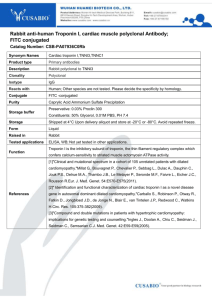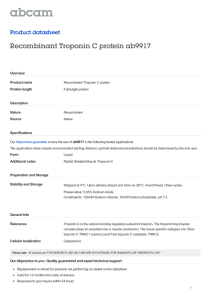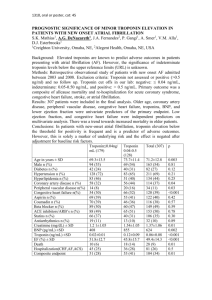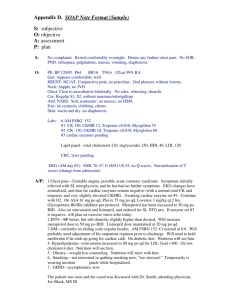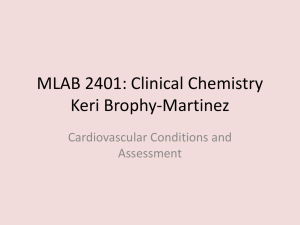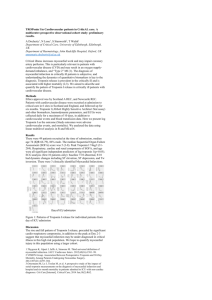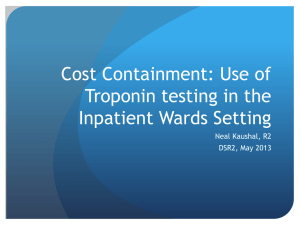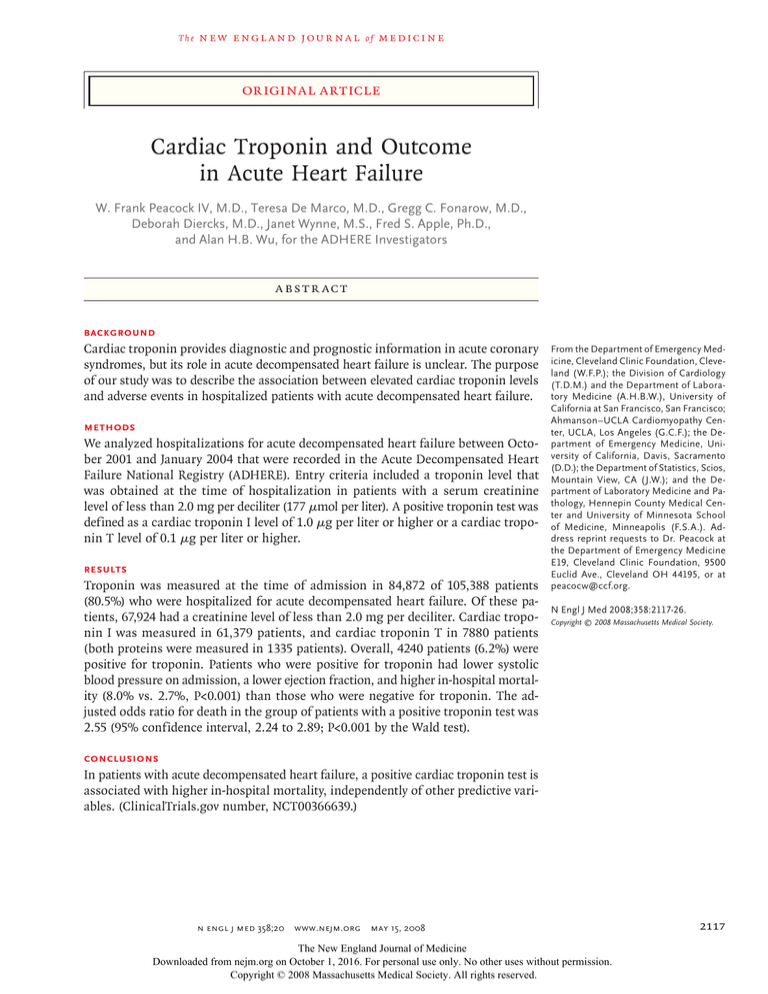
The
n e w e ng l a n d j o u r na l
of
m e dic i n e
original article
Cardiac Troponin and Outcome
in Acute Heart Failure
W. Frank Peacock IV, M.D., Teresa De Marco, M.D., Gregg C. Fonarow, M.D.,
Deborah Diercks, M.D., Janet Wynne, M.S., Fred S. Apple, Ph.D.,
and Alan H.B. Wu, for the ADHERE Investigators
A bs t r ac t
Background
Cardiac troponin provides diagnostic and prognostic information in acute coronary
syndromes, but its role in acute decompensated heart failure is unclear. The purpose
of our study was to describe the association between elevated cardiac troponin levels
and adverse events in hospitalized patients with acute decompensated heart failure.
Methods
We analyzed hospitalizations for acute decompensated heart failure between October 2001 and January 2004 that were recorded in the Acute Decompensated Heart
Failure National Registry (ADHERE). Entry criteria included a troponin level that
was obtained at the time of hospitalization in patients with a serum creatinine
level of less than 2.0 mg per deciliter (177 μmol per liter). A positive troponin test was
defined as a cardiac troponin I level of 1.0 μg per liter or higher or a cardiac troponin T level of 0.1 μg per liter or higher.
Results
Troponin was measured at the time of admission in 84,872 of 105,388 patients
(80.5%) who were hospitalized for acute decompensated heart failure. Of these patients, 67,924 had a creatinine level of less than 2.0 mg per deciliter. Cardiac troponin I was measured in 61,379 patients, and cardiac troponin T in 7880 patients
(both proteins were measured in 1335 patients). Overall, 4240 patients (6.2%) were
positive for troponin. Patients who were positive for troponin had lower systolic
blood pressure on admission, a lower ejection fraction, and higher in-hospital mortality (8.0% vs. 2.7%, P<0.001) than those who were negative for troponin. The adjusted odds ratio for death in the group of patients with a positive troponin test was
2.55 (95% confidence interval, 2.24 to 2.89; P<0.001 by the Wald test).
From the Department of Emergency Medicine, Cleveland Clinic Foundation, Cleveland (W.F.P.); the Division of Cardiology
(T.D.M.) and the Department of Laboratory Medicine (A.H.B.W.), University of
California at San Francisco, San Francisco;
Ahmanson–UCLA Cardiomyopathy Center, UCLA, Los Angeles (G.C.F.); the Department of Emergency Medicine, University of California, Davis, Sacramento
(D.D.); the Department of Statistics, Scios,
Mountain View, CA (J.W.); and the Department of Laboratory Medicine and Pathology, Hennepin County Medical Center and University of Minnesota School
of Medicine, Minneapolis (F.S.A.). Address reprint requests to Dr. Peacock at
the Department of Emergency Medicine
E19, Cleveland Clinic Foundation, 9500
Euclid Ave., Cleveland OH 44195, or at
peacocw@ccf.org.
N Engl J Med 2008;358:2117-26.
Copyright © 2008 Massachusetts Medical Society.
Conclusions
In patients with acute decompensated heart failure, a positive cardiac troponin test is
associated with higher in-hospital mortality, independently of other predictive variables. (ClinicalTrials.gov number, NCT00366639.)
n engl j med 358;20 www.nejm.org may 15, 2008
The New England Journal of Medicine
Downloaded from nejm.org on October 1, 2016. For personal use only. No other uses without permission.
Copyright © 2008 Massachusetts Medical Society. All rights reserved.
2117
The
n e w e ng l a n d j o u r na l
T
he united states is in the midst of a
heart failure epidemic. More than 1 million
hospitalizations in 2007 were for heart failure, and the Centers for Medicaid and Medicare
Services currently spends more on the diagnosis
and treatment of this condition than on any other
medical condition.1 Most patients with heart failure are admitted to the hospital from the emergency department, where a comprehensive evaluation is required to determine the precipitating
cause of the condition. Unfortunately, the definition of a comprehensive evaluation has not been
established. Since coronary artery disease is the
most common cause of heart failure in the United
States, it is appropriate to evaluate patients with
heart failure for myocardial ischemia. Initial evaluation of patients who present with heart failure
often includes a focused history, physical examination, electrocardiogram, and measurement of
biomarkers. Although this approach is well validated for the evaluation of acute coronary syndromes, except for specific laboratory-based investigations, an objective risk-stratification process
for the evaluation of acute decompensated heart
failure is lacking.
The value of measuring serum cardiac troponin when a patient presents with acute decompen­
sated heart failure remains uncertain. Although
several limited analyses suggest that an increase
in serum cardiac troponin levels is associated
with adverse long-term outcomes,2-5 the shortterm implications are less clearly defined. Some
small trials involving patients with heart failure
have shown that increases in troponin levels, even
in the absence of chest pain or an acute coronary
syndrome, correlate with a poor prognosis5-7 and
that detectable troponin, at any level, is associated with impaired hemodynamics, a progressive
decline in left ventricular systolic function, and
shortened survival.5-8 We conducted a large study
to describe short-term outcomes associated with
elevated troponin levels on admission in hospitalized patients with acute decompensated heart
failure.
Me thods
Registry Data
With the use of data from the Acute Decompensated Heart Failure National Registry (ADHERE),
we analyzed outcomes associated with elevated
troponin levels in patients with acute decompen2118
of
m e dic i n e
sated heart failure. The methods and design of
ADHERE have been published previously.9 Briefly,
ADHERE is an observational registry of individual hospital episodes, from initial presentation
through discharge, involving patients with an ultimate discharge diagnosis of acute decompensated heart failure. We examined records from 274
hospitals, from October 2001 through January
2004. Inclusion criteria were hospitalization and
documentation of the measurement of cardiac
troponin I or cardiac troponin T at the initial evaluation (defined as within 24 hours after admission). Because renal dysfunction may influence
cardiac troponin concentrations, patients with a
serum creatinine level higher than 2.0 mg per
deciliter (176.8 μmol per liter) were excluded from
the study. Ischemic heart failure was defined as
the cause of the acute decompensated heart failure if the patient reported a history of coronary
artery disease or myocardial infarction. Race or
ethnic group was self-reported.
Troponin Measurements
We chose to pool cardiac troponin I and cardiac
troponin T measurements, first, because an elevated value for either one is consistent with an
acute coronary syndrome, and second, because
they are used interchangeably in clinical practice
and often in a qualitative fashion (as positive or
negative for troponin), especially during the initial
evaluation (the period examined in this analysis).
Since these molecules are treated identically for
all other conditions in the clinical setting, we
chose to treat them identically in this investigation of acute decompensated heart failure.
ADHERE collected assay data but did not control for the assay platform. Measurement of cardiac troponin T is performed on a uniform platform in the United States, and the cutoff point
of 0.1 μg per liter or higher for detection of a
myocardial infarction has been defined by the
manufacturer and derived from a receiver-operating-characteristic (ROC) curve. Because troponin I has different cutoff points that are dependent on the platform used (more than a dozen
different assays), a predefined cutoff point was
set at 1.0 μg per liter or higher. This cutoff point
was based on expert consensus, approximating
values defined from a ROC curve that was optimized for the detection of myocardial infarction.
Qualitative tests were considered to be positive
if they were recorded as such.
n engl j med 358;20 www.nejm.org may 15, 2008
The New England Journal of Medicine
Downloaded from nejm.org on October 1, 2016. For personal use only. No other uses without permission.
Copyright © 2008 Massachusetts Medical Society. All rights reserved.
Troponin and Outcomes of Heart Failure
Statistical Analysis
The primary outcome was in-hospital mortality
from all causes, and the secondary outcomes included differences in medical management, procedures, and length of stay between the troponin-positive and troponin-negative cohorts. All
outcomes were specified before the data were examined. We also examined associations between
therapy and mortality, controlling for troponin
in patients who received inotropes or vasodilators, but not both.
Analysis of variance, Wilcoxon rank-sum tests,
or chi-square tests were used for univariate analyses. All reported P values are two-sided. Because
of anticipated differences between troponin-positive and troponin-negative groups with respect
to medical history and clinical characteristics at
presentation, mortality was adjusted for relevant
prognostic factors. Of 80 variables collected in
ADHERE, the most important predictors of inhospital mortality have been previously identified
by classification-and-regression-tree (CART) analy­
sis and logistic-regression models.10 For this
analysis, mortality according to troponin group
was compared by logistic regression adjusted for
age, blood urea nitrogen, systolic blood pressure,
diastolic blood pressure, serum creatinine, serum
sodium, heart rate, and dyspnea at rest. Overall,
1.2% of the records were excluded because of
missing values. Since there was little variation in
the rate of measurement of troponin by center,
hospital type, or region, hierarchical analysis was
not performed. Analyses were performed with the
use of SAS software, version 8.2 (SAS Institute).
The study was designed by all the authors; the
data were gathered by the 274 hospitals that participated in ADHERE, and the statistical analysis
was performed by ADHERE statisticians.
R e sult s
Troponin Levels and Characteristics
of the Patients
Troponin levels were measured at the time of admission in 84,872 of 105,388 hospitalized patients
(80.5%), with 67,924 patients meeting all inclusion
and exclusion criteria. Overall, 4240 patients (6.2%)
were positive for troponin on admission. Characteristics of the patients according to whether
they were positive or negative for troponin are
summarized in Table 1. There were small but significant differences between the two troponin
cohorts. On admission, troponin-positive patients
had lower systolic blood pressure and lower ejection fractions but were less likely to have atrial
fibrillation.
Cardiac troponin I was measured in 61,379 pa­
tients (90.4%), and cardiac troponin T in 7880
patients (11.6%). The values were positive in 3253
patients (5.3%) and 1035 patients (13.1%), respectively. Both markers were measured in 1335 patients (2.0%); of these, 48 patients were positive
for both, 1059 were negative for both, 71 were
positive for cardiac troponin I only, and 157 were
positive for cardiac troponin T only. For this
analysis, if either marker was above the defined
cutoff point, the patient was considered to be
troponin-positive. Since both cardiac troponin I
and cardiac troponin T were measured in only 2%
of patients, no comparison between these proteins was made.
In-Hospital Mortality
Overall, troponin-positive patients had a higher
rate of in-hospital mortality than troponin-negative patients (8.0% vs. 2.7%, P<0.001). Actuarial
analysis showed that within 1 day after admission,
in-hospital mortality was higher for troponinpositive than for troponin-negative patients (Fig. 1).
When the troponin level was examined as a continuous variable, higher values were also associated with higher mortality. The adjusted odds
ratio for death among patients with a positive
troponin test was 2.55 (95% confidence interval
[CI], 2.24 to 2.89; P<0.001). Increased mortality
was observed with elevations in either cardiac troponin T or cardiac troponin I.
Mortality according to quartiles of cardiac
troponin T and cardiac troponin I levels is shown
in Figure 2. For cardiac troponin I, the adjusted
odds ratio for death in a comparison of quartile
4 with quartile 1 was 2.33 (95% CI, 1.98 to 2.75;
P<0.001). The first two troponin T quartiles were
unequal in size because 37% of the records had
a value of 0.01 μg per liter. In addition, because
qualitative troponin results were not included in
the quartile analysis, this cohort was smaller
than the total in the study.
Ischemic heart failure, which was reported as
the cause of the acute decompensated heart failure in 53% and 52% of troponin-positive and
troponin-negative patients, respectively, was not
a useful discriminator of troponin status, nor was
it predictive of mortality. Among troponin-posi-
n engl j med 358;20 www.nejm.org may 15, 2008
The New England Journal of Medicine
Downloaded from nejm.org on October 1, 2016. For personal use only. No other uses without permission.
Copyright © 2008 Massachusetts Medical Society. All rights reserved.
2119
The
n e w e ng l a n d j o u r na l
tive patients, mortality was 8.4% for those with
ischemic heart failure and 7.4% for those without ischemic heart failure; among troponinnegative patients, mortality was 2.8% and 2.6%,
respectively, for these groups.
of
m e dic i n e
Treatment, Troponin Status, and Mortality
Although the rate of use of diuretics was similar
in the troponin-positive and troponin-negative cohorts (Table 1), troponin-positive patients were
more likely to be receiving nitroglycerin, inotropic
Table 1. Patient Characteristics and Treatment According to Troponin Status.*
Positive for Troponin Negative for Troponin
(N = 4240)
(N = 63,684)
Characteristic
Age (yr)
P Value
73.3±14.0
72.9±14.0
0.05
48
45
<0.001
73
70
0.27
Black
19
20
Other
4
4
Heart failure due to ischemia (% of patients)
53
52
<0.001
Hospitalization for heart failure within the past 6 mo
(% of patients)
31
36
<0.001
<0.001
Male sex (% of patients)
Race (% of patients)†
White
Medical conditions (% of patients)
Atrial fibrillation
23
31
Coronary artery disease
58
56
0.002
Prior myocardial infarction
37
30
<0.001
Prior coronary artery disease or myocardial infarction
61
58
<0.001
Chronic obstructive pulmonary disease or asthma
29
32
<0.001
Ventricular tachycardia or ventricular fibrillation
7
8
0.03
Diabetes
42
41
0.19
Hypertension
72
73
0.54
Hyperlipidemia
36
34
0.02
Current smoker
16
14
0.001
Peripheral vascular disease
18
16
<0.001
Condition requiring placement of a pacemaker
12
16
<0.001
141±32
147±32
<0.001
35±16
39±17
<0.001
61
51
<0.001
111.4±37.4
113.8±41.0
<0.001
29
33
<0.001
Initial clinical findings
Systolic pressure (mm Hg)
Left ventricular ejection fraction
Mean (%)
<40% or moderate or severe (% of patients)
Initial electrocardiogram
QRS (msec)
QRS >120 msec (% of patients)
Symptoms on presentation (% of patients)
2120
Dyspnea
87
91
<0.001
Edema
60
66
<0.001
Fatigue
30
30
0.76
Pulmonary edema
88
88
0.30
Rales
72
70
0.03
n engl j med 358;20 www.nejm.org may 15, 2008
The New England Journal of Medicine
Downloaded from nejm.org on October 1, 2016. For personal use only. No other uses without permission.
Copyright © 2008 Massachusetts Medical Society. All rights reserved.
Troponin and Outcomes of Heart Failure
Table 1. (Continued.)
Positive for Troponin Negative for Troponin
(N = 4240)
(N = 63,684)
Characteristic
P Value
In-hospital treatment
Interval to first diuretic (hr)
Median
2.4
2.2
1.0−6.8
1.0−5.1
91
93
<0.001
Furosemide
88
89
<0.001
Bumetanide
8
7
0.004
Other
3
3
0.12
0.746
Interquartile range
<0.001
Diuretics (% of patients)
Any
Interval to first vasoactive agent (hr)
Median
4.1
4.3
1.1−21.3
1.0−19.8
Any
18
9
<0.001
Dobutamine
9
5
<0.001
Interquartile range
Inotropes (% of patients)
Dopamine
11
5
<0.001
Milrinone
4
2
<0.001
Vasodilators (% of patients)
Any
28
18
<0.001
Nesiritide
11
9
<0.001
Nitroglycerin
20
10
<0.001
Nitroprusside
2
1
<0.001
*Plus−minus values are means ±SD.
†Race was ascertained from hospital records.
agents, and vasodilators than were troponin-negative patients. There were also differences in resource
utilization and mortality according to treatment
(Tables 2 and 3 and Fig. 3). However, among troponin-positive patients, mortality, as indicated by
the adjusted odds ratio, was independent of treatment. The adjusted odds ratio for the troponinpositive group as compared with the troponin-negative group was 1.84 (95% CI, 1.43 to 2.36) in the
subgroup of patients who were treated with inotropic agents and 1.96 (95% CI, 1.37 to 2.81) in the
subgroup treated with vasodilators (P<0.001 for
both comparisons by the Wald test). Finally, there
was no interaction between treatment and troponin status with respect to mortality. The adjusted
odds ratio for death among patients receiving inotropic agents as compared with those receiving
vasodilators was 4.44 (95% CI, 2.90 to 6.81) for
the troponin-positive group and 4.54 (95% CI, 3.75
to 5.49) for the troponin-negative group (P<0.001
for both comparisons by the Wald test).
Dis cus sion
In our data set, which included data from 105,388
patients, troponin was measured in 80.5% of the
hospitalized patients with acute decompensated
heart failure as a part of their routine care. Of
these patients, 6.2% were found to be positive for
troponin, including those with and those without a history of coronary artery disease or myocardial infarction. Like patients presenting with
an acute coronary syndrome, patients presenting
with acute decompensated heart failure and a positive troponin status were found to be a high-risk
cohort. Patients in this cohort, as compared with
those who were negative for troponin, required
more cardiac procedures and longer hospitalization and had a higher risk of in-hospital death,
even after adjustment for other risk factors. These
results suggest that measurement of troponin
adds important prognostic information to the initial evaluation of patients with acute decompen-
n engl j med 358;20 www.nejm.org may 15, 2008
The New England Journal of Medicine
Downloaded from nejm.org on October 1, 2016. For personal use only. No other uses without permission.
Copyright © 2008 Massachusetts Medical Society. All rights reserved.
2121
The
n e w e ng l a n d j o u r na l
25
Cumulative Mortality (%)
20
Troponin-positive
15
10
5
Troponin-negative
0
0
1
2
3
4
5
6
7
8
9
10
11
12
13
14
15
Days in Hospital
Figure 1. Mortality According to Number of Days in the Hospital and Troponin
RETAKE
1st
AUTHOR: Peacock
Status at Presentation.
ICM
2nd
FIGURE: 1 of 3
REG
F
P<0.001 by the log-rank test. Dashed lines show 95% confidence
3rd intervals.
CASE
EMail
Enon
Revised
4-C
H/T
SIZE
22p3
AUTHOR, PLEASE NOTE:
Figure has been redrawn and type has been reset.
Please check carefully.
In-Hospital Mortality (%)
A
ARTIST: ts
Line
H/T
Combo
8
JOB: 35815
ISSUE: 04-10-08
5.3
6
4
2
0
2.0
≤ 0.04
3.4
2.7
>0.04–0.10
>0.10–0.20
>0.20
Troponin I Quartile
No. of Patients
11,090
10,367
9323
9534
In-Hospital Mortality (%)
B
8
6.3
6
4
2
0
3.3
2.8
1.7
≤ 0.01
>0.01–0.02
>0.02–0.06
>0.06
Troponin T Quartile
No. of Patients
1773
502
1138
1119
Figure 2. In-Hospital Mortality According to Troponin I or Troponin T Quartile.
1st
AUTHOR:
P<0.001 by theICM
chi-square
test Peacock
for all comparisons. RETAKE
REG F
2nd
3rd
FIGURE: 2 of 3
CASE
EMail
Enon
2122
ARTIST: ts
Line
H/T
Combo
4-C
H/T
of
m e dic i n e
sated heart failure and should be considered as
part of an early assessment of risk.
Since patients who are positive for troponin
have a disproportionately high mortality, an asso­
ciation that is independent of other well-validated
risk factors for acute decompensated heart failure, the results of troponin tests should be factored into decisions that are made with respect to
triage and management. Although we did not
study differential management, in our opinion,
patients with an increased risk of death should
undergo more intensive cardiovascular monitoring; they may require admission to a critical care
unit or cardiac telemetry. Our findings add to the
existing risk-stratification data for predicting the
short-term risk of death among patients with
acute decompensated heart failure. Patients with
an initial blood urea nitrogen level of more than
43 mg per deciliter (15.4 mmol per liter), systolic
blood pressure of less than 115 mm Hg, or a
creatinine level of more than 2.75 mg per deciliter (243.1 μmol per liter) have high short-term
mortality, exceeding 22% if all three factors are
present.10 Since these mortality rates are higher
than those that are associated with most episodes
of acute myocardial infarction, a more aggressive
therapeutic approach is justified. A positive troponin status adds incremental prognostic information to that obtained from vital signs and other
laboratory data.
Conversely, we found that a negative troponin
status was associated with a short-term mortality rate that was nearly two thirds lower than the
rate with a positive troponin level. Although the
absence of high-risk predictors does not equate
with low risk, the absence of detectable troponin
may be helpful in planning treatment. When considered in the context of other predictors of low
risk, a negative troponin test may aid in the identification of patients for whom less intense monitoring and therapy are appropriate. Few studies
have examined predictors of low risk in patients
with acute decompensated heart failure. In a study
of patients with acute decompensated heart failure who were in an emergency department observation unit,11 a blood urea nitrogen level of
less than 30 mg per deciliter (10.7 mmol per liter)
was associated with successful treatment in a
short-stay unit. Another analysis showed that an
elevated blood pressure (>160 mm Hg) or a nega-
Revised
SIZE
16p6
AUTHOR, PLEASE NOTE:
Figure has been redrawn and type has been reset.
n engl j med 358;20 www.nejm.org may 15, 2008
Please check carefully.
The New England Journal of Medicine
JOB: 35815 Downloaded from nejm.org on
ISSUE:
04-10-08
October
1, 2016. For personal use only. No other uses without permission.
Copyright © 2008 Massachusetts Medical Society. All rights reserved.
Troponin and Outcomes of Heart Failure
Table 2. Resource Utilization According to Troponin Status.*
Positive for Troponin
(N = 4240)
Resource
Negative for Troponin
(N = 63,684)
P Value
Odds Ratio (95% CI)
Intensive care unit
Any time — no. (%)
1565 (37)
10,493 (16)
<0.001
Median days (IQR)
2.9 (1.6−5.0)
2.3 (1.2−4.1)
<0.001
Adjusted mean days
4.1
3.7
0.007
Median stay (IQR)
5.1 (3.2−8.3)
4.1 (2.8−6.7)
<0.001
Adjusted mean stay
6.6
5.5
<0.001
164 (4)
478 (1)
<0.001
5.46 (4.54−6.57)
Hospital — days
Procedures — no. (%)
CABG
IABP
113 (3)
192 (<1)
<0.001
8.03 (6.30−10.2)
Cardiac catheterization
1002 (24)
6383 (10)
<0.001
3.04 (2.81−3.28)
Mechanical ventilation
479 (11)
641 (1)
<0.001
2.68 (2.41−2.99)
*Means were adjusted for age, blood urea nitrogen level, systolic and diastolic blood pressure, creatinine level, sodium
level, heart rate, and presence or absence of dyspnea at rest. Odds ratios are for the troponin-positive group as compared with the troponin-negative group and were adjusted for age, blood urea nitrogen level, systolic and diastolic
blood pressure, creatinine level, sodium level, heart rate, and presence or absence of dyspnea at rest. CABG denotes
coronary-artery bypass graft, IABP intraaortic balloon pump, and IQR interquartile range.
Table 3. In-Hospital Mortality According to Treatment.
Positive for Troponin Negative for Troponin
(N = 4240)
(N = 63,684)
Treatment
P Value
Odds Ratio (95% CI)*
460/3676 (13)
<0.001
1.84 (1.43−2.36)
no./total no. (%)
Inotropes only
Any
104/461 (23)
Dobutamine
39/209 (19)
180/1847 (10)
<0.001
1.96 (1.32−2.91)
Dopamine
85/293 (29)
366/1797 (20)
<0.001
1.49 (1.12−1.99)
Milrinone
24/85 (28)
58/738 (8)
<0.001
4.65 (2.58−8.38)
Vasodilators only
Any
42/882 (5)
203/9308 (2)
<0.001
1.96 (1.37−2.81)
Nesiritide
14/324 (4)
125/4335 (3)
0.14
1.44 (0.80−2.59)
Nitroglycerin
32/630 (5)
93/5397 (2)
<0.001
2.55 (1.65−3.95)
Nitroprusside
0/28
0.35
NA
7/227 (3)
*Odds ratios are for the troponin-positive group as compared with the troponin-negative group and were adjusted for
age, blood urea nitrogen level, systolic and diastolic blood pressure, creatinine level, sodium level, heart rate, and presence or absence of dyspnea at rest. NA denotes not applicable.
tive troponin test was associated with discharge
from the hospital within 24 hours and an absence
of adverse outcomes within 30 days.12 These
analyses suggest that initial blood pressure, renal
function, and troponin status are the most use-
ful risk-stratification data in patients presenting
with acute decompensated heart failure.
In the current study, patients who were positive for troponin required longer hospitalization
and greater use of resources. Since hospitaliza-
n engl j med 358;20 www.nejm.org may 15, 2008
The New England Journal of Medicine
Downloaded from nejm.org on October 1, 2016. For personal use only. No other uses without permission.
Copyright © 2008 Massachusetts Medical Society. All rights reserved.
2123
The
In-Hospital Mortality (%)
24
n e w e ng l a n d j o u r na l
of
m e dic i n e
23
20
16
13
12
8
0
No. of Patients
5
4
2
Troponin-Positive,
Inotrope
Troponin-Negative,
Inotrope
Troponin-Positive,
Vasodilator
Troponin-Negative,
Vasodilator
461
3676
882
9308
Figure 3. Mortality According to Type of Treatment and Troponin Status.
P<0.001 by the chi-square test for the association between troponin status and mortality within the vasodilator and
inotrope groups.
tion and length of stay in an intensive care unit ted for worsening heart failure, in-hospital death
are important determinants of cost, early identi- from cardiac causes occurred in 10 of 45 patients
fication of patients who will require greater (22%) who had cardiac troponin T levels higher
1st as compared with 4 of 53
AUTHOR: Peacock
resources could allow early implementation
of than 0.033 RETAKE
μg per liter,
ICM
2nd
FIGURE:
3
of
3
aggressive therapy. The impactREG
of Fearly risk strati- (8%) who had lower
3rd cardiac troponin T levels
3
CASE
Revised
fication has been supported in other studies of (P = 0.04). Cardiac
troponin T and brain natriLine
4-C
EMail
SIZE considered together, identiacute decompensated heart failure.
In
the B-Type
uretic
peptide,
when
ARTIST:
ts
H/T
H/T
16p6
Enon
Natriuretic Peptide for Acute Shortness
of Breath Combo
fied patients at low risk (3%), intermediate risk
AUTHOR,
NOTE:
Evaluation (BASEL) trial,13 simply establishing
an PLEASE
(11%),
and high risk (31%) for in-hospital death
Figure has been redrawn and type has been reset.
early, accurate diagnosis of heart failure decreased
(P carefully.
= 0.006). A study of 159 patients with acute dePlease check
both length of stay and costs. Early risk stratifi- compensated heart failure showed that 24 patients
JOB: 35815
04-10-08
cation may help identify patients
who are likely (15%) hadISSUE:
high
levels of troponin.16 Of these
to receive the greatest benefit from early intensive patients, 20.8% died during hospitalization or had
therapy.
refractory heart failure, as compared with 3.7%
In an analysis of subjects in the Enhanced Feed­ of those with low troponin levels (odds ratio, 6.8;
back for Effective Cardiac Treatment (EFFECT) 95% CI, 1.5 to 31.2). Finally, in a subgroup analystudy, You et al. evaluated cardiac troponin I and sis of 133 patients in the Randomized Intravemortality in 2025 patients who were hospitalized nous TeZosentan 4 (RITZ-4) study, which involved
with heart failure.14 They reported that levels of patients with acute decompensated heart failure
cardiac troponin I higher than 0.5 μg per liter, or an acute coronary syndrome, an elevated carwhich were present in 34.5% of the patients, were diac troponin I level before randomization was
an independent predictor of short-term death, associated with an increased rate of the composwith a dose–response relationship. However, ap- ite end point of death, worsening heart failure,
plying these findings to those from centers that recurrent ischemia, or new myocardial infarction
used a different assay platform from that used within 72 hours (odds ratio, 1.15; 95% CI, 1.01
by EFFECT may be problematic. Furthermore, the to 1.32).17
rate of elevated troponin levels in the EFFECT
In hospitalized patients with acute decompenstudy is markedly higher than the rate in the cur- sated heart failure, but without classic signs of
rent study and in earlier analyses.15
acute myocardial infarction, troponin is correlat­
Smaller studies of patients with heart failure ed with several physiological variables.4,18 In 26
have shown similar implications of elevated tro- hospitalized patients with heart failure, a signifiponin levels with respect to short-term morbidity cant correlation was found between cardiac troand mortality. In 98 consecutive patients admit- ponin T status and the left-ventricular-mass in2124
n engl j med 358;20 www.nejm.org may 15, 2008
The New England Journal of Medicine
Downloaded from nejm.org on October 1, 2016. For personal use only. No other uses without permission.
Copyright © 2008 Massachusetts Medical Society. All rights reserved.
Troponin and Outcomes of Heart Failure
dex.4 In a study involving 40 hospitalized patients
with heart failure,18 troponin status was correlated with blood pressure and the presence or
absence of left ventricular hypertrophy as assessed by electrocardiography. Several hypotheses, including subendocardial ischemia due to a
mismatch between myocardial oxygen supply and
demand, have been proposed as explanations for
these associations, but the mechanisms by which
these features cause increases in troponin levels
in the absence of an acute coronary syndrome
remain uncertain.
An elevation in cardiac troponin can indicate
the presence of myocyte injury or death.19 This
model recognizes progressive myocyte loss as a
prominent pathophysiological mechanism in the
evolution of cardiac dysfunction and acute decompensated heart failure.20 The pathophysiological factors that that are thought to be responsible
for ongoing myocyte injury or cell death include
excessive adrenergic stimulation through renin,
angiotensin, aldosterone, or endothelin signaling
pathways, abnormalities in calcium handling, inflammatory cytokines, nitric oxide, and oxidative
and mechanical stress.6
National guidelines for the evaluation of an
acute coronary syndrome recommend that levels
of cardiac troponin and brain natriuretic peptide
or N-terminal pro–brain natriuretic peptide be
used for prognosis and risk stratification. Current
guidelines for the evaluation of heart failure do
not mention troponin and recommend the measurement of brain natriuretic peptide only in
cases in which the diagnosis is uncertain. Our
data suggest that the measurement of troponin
levels in patients who present with heart failure
provides independent prognostic information regarding in-hospital death and other clinical outcomes and can be useful for risk stratification of
such patients.
Our study has several limitations. Since we
performed a retrospective analysis of registry
data, we cannot establish cause and effect. However, the associations are strong and are consistent with prior analyses of troponin in patients
with acute decompensated heart failure. Furthermore, the ADHERE registry is a large data set
based on a broad sample of patients with heart
failure; thus, the data are not confounded as a
result of being based on a prespecified subgroup
of patients receiving predefined treatments.
A number of factors could have affected the
results of the troponin tests. First, we used the re­
sults of various cardiac troponin I assays for
which we defined cutoff points, rather than core
laboratory results. Since many cardiac troponin
I platforms are used in clinical practice, each
with a unique cutoff point, our prespecified cutoff point may have introduced variability in assay
performance.21 However, although a single assay
platform could increase the strength of the causality association, the generalizability of our data
allows the findings to be considered in actual
patient-care scenarios. Second, bias may have
been introduced because we were unable to analyze those patients with heart failure in whom
troponin was not assessed and are unable to determine why physicians obtained, or did not obtain, troponin measurements. Because troponin
was measured only at the time of admission to
the hospital, we cannot comment on the number
of patients with an acute myocardial infarction,
since a typical rise and fall of cardiac biomarkers
was not recorded. Finally, the prognostic information that can be gained from an analysis of
the interaction of troponin with other biomarkers,
such as brain natriuretic peptide, was not explored in this study.
Several limitations of the study are a function
of the registry itself. Inclusion in ADHERE required a discharge diagnosis of heart failure,
with the determination of a nonischemic cause
made at the discretion of the investigator. Because the diagnosis was not objectively ascertained, some patients with both heart failure and
an acute coronary syndrome may have been included in our analysis. However, when only data
from patients who were categorized as having
nonischemic heart failure were analyzed, troponin levels retained their prognostic significance.
In addition, ADHERE did not consistently report
the cause of death, and noncardiac events may
have contributed to the mortality rate. However,
we expect that the incidence of noncardiac
events would be equally distributed between the
troponin-positive and troponin-negative groups.
Finally, ADHERE recorded only in-hospital outcomes, not deaths after discharge. Consequently,
our findings may underrepresent adverse outcomes, with possible prognostic implications,
since others have found that mortality at 30 days
may exceed in-hospital mortality.14
In hospitalized patients with acute decompensated heart failure, a positive troponin test
n engl j med 358;20 www.nejm.org may 15, 2008
The New England Journal of Medicine
Downloaded from nejm.org on October 1, 2016. For personal use only. No other uses without permission.
Copyright © 2008 Massachusetts Medical Society. All rights reserved.
2125
Troponin and Outcomes of Heart Failure
is associated with more frequent adverse events,
including increased in-hospital mortality, independently of treatment and other prognostic
variables. Patients with heart failure who were
positive for troponin required greater use of
hospital resources, including longer stays in the
hospital and in the intensive care unit. We have
identified a cohort of patients who have an elevated risk of adverse outcomes. Future research
that examines therapies to mitigate these outcomes is needed.
Supported by Scios.
Dr. Peacock reports serving as a consultant to Abbott, Beckman Coulter, Biosite, Ortho Clinical Diagnostics, and Response
Biomedical; receiving honoraria from Abbott, Beckman Coulter,
Biosite, Ortho-Biotech, and Scios; and receiving grant support
from Abbott, Biosite, and Scios. Dr. Fonarow reports serving
as a consultant to Scios; receiving honoraria from Scios and
Biosite; and receiving grant support from the National Heart,
Lung, and Blood Institute. Dr. Diercks reports receiving honoraria from Scios and grant support from Dade Behring. Ms.
Wynne reports having been an employee of Johnson & Johnson.
Dr. Apple reports serving as a consultant to Abbott, Ortho
Clinical Diagnostics, and Biosite; receiving honoraria from Abbott and bioMérieux; and receiving grant support from Ortho
Clinical Diagnostics, bioMérieux, Abbott, Dade Behring, DPC,
Bayer, Response Biomedical, Mitsubishi Kagaku, and Roche.
No other potential conflict of interest relevant to this article
was reported.
References
1. Rosamond W, Flegal K, Friday G, et al.
Heart disease and stroke statistics —
2007 update: a report from the American
Heart Association Statistics Committee
and Stroke Statistics Subcommittee. Circulation 2007;115(5):e69-e171.
2. Goto T, Takase H, Toriyama T, et al.
Circulating concentrations of cardiac proteins indicate the severity of congestive
heart failure. Heart 2003;89:1303-7.
3. Ishii J, Nomura M, Nakamura Y, et al.
Risk stratification using a combination of
cardiac troponin T and brain natriuretic
peptide in patients hospitalized for worsening chronic heart failure. Am J Cardiol
2002;89:691-5.
4. Löwbeer C, Gustafsson SA, Seeberger
A, Bouvier F, Hulting J. Serum cardiac troponin T in patients hospitalized with
heart failure is associated with left ventricular hypertrophy and systolic dysfunction. Scand J Clin Lab Invest 2004;64:
667-76.
5. Horwich TB, Patel J, MacLellan WR,
Fonarow GC. Cardiac troponin I is associated with impaired hemodynamics, progressive left ventricular dysfunction, and
increased mortality rates in advanced heart
failure. Circulation 2003;108:833-8.
6. Fonarow GC, Horwich TB. Combining natriuretic peptides and necrosis mark­
ers in determining prognosis in heart failure. Rev Cardiovasc Med 2003;4:Suppl 4:
S20-S28.
7. Del Carlo CH, O’Connor CM. Cardiac
troponins in congestive heart failure. Am
Heart J 1999;138:646-53.
8. Xue C, Yu H, Li R, et al. Clinical sig-
nificance of serum cardiac troponin T in
patients with congestive heart failure.
Chin Med J (Engl) 2003;116:469-71.
9. Adams KF Jr, Fonarow GC, Emerman
CL, et al. Characteristics and outcomes of
patients hospitalized for heart failure in
the United States: rationale, design, and
preliminary observations from the Acute
Decompensated Heart Failure National
Registry (ADHERE). Am Heart J 2005;149:
209-16.
10. Fonarow GC, Adams KF Jr, Abraham
WT, et al. Risk stratification for in-hospital mortality in acutely decompensated
heart failure: classification and regression
tree analysis. JAMA 2005;293:572-80.
11. Burkhardt J, Peacock WF, Emerman
CL. Predictors of emergency department
observation unit outcomes. Acad Emerg
Med 2005;12:869-74.
12. Diercks DB, Peacock WF, Kirk JD Weber JE. ED patients with heart failure:
identification of an observational unitappropriate cohort. Am J Emerg Med 2006;
24:319-24.
13. Mueller C, Scholer A, Laule-Kilian K,
et al. Use of B-type natriuretic peptide in
the evaluation and management of acute
dyspnea. N Engl J Med 2004;350:647-54.
14. You JJ, Austin PC, Alter DA, Ko DT, Tu
JV. Relation between cardiac troponin I and
mortality in acute decompensated heart
failure. Am Heart J 2007;153:462-70.
15. Peacock WF, Emerman CL, Doleh M,
Civic K, Butt S. Retrospective review: the
incidence of non-ST segment elevation MI
in emergency department patients presenting with decompensated heart failure.
Congest Heart Fail 2003;9:303-8.
16. Perna ER, Macin SM, Cimbaro Canella JP, et al. High levels of troponin T are
associated with ventricular remodeling
and adverse in-hospital outcome in heart
failure. Med Sci Monit 2004;10:CR90-5.
17. Gattis WA, O’Connor CM, Hasselblad
V, Adams KF Jr, Kobron I, Gheorghiade M.
Usefulness of an elevated troponin-I in
predicting clinical events in patients admitted with acute heart failure and acute
coronary syndrome (from the RITZ-4 trial).
Am J Cardiol 2004;93:1436-7.
18. Angheloiu GO, Dickerson RP, Rava­
khah K. Etiology of troponin I elevation
in patients with congestive heart failure
and low clinical suspicion of myocardial
infarction. Resuscitation 2004;63:195-201.
19. Wu AH, Ford L. Release of cardiac troponin in acute coronary syndromes: is­
chemia or necrosis? Clin Chim Acta 1999;
284:161-74.
20. Mann DL. Mechanisms and models in
heart failure: a combinatorial approach.
Circulation 1999;100:999-1008.
21. Apple FS, Wu AHB, Jaffe AS. European
Society of Cardiology and American College of Cardiology guidelines for redefinition of myocardial infarction: how to use
existing assays clinically and for clinical
trials. Am Heart J 2002;144:981-6.
Copyright © 2008 Massachusetts Medical Society.
journal editorial fellow
The Journal’s editorial office invites applications for a one-year
research fellowship beginning in July 2009 from individuals at any
stage of training. The editorial fellow will work on Journal projects
and will participate in the day-to-day editorial activities of the Journal
but is expected in addition to have his or her own independent
projects. Please send curriculum vitae and research interests
to the Editor-in-Chief, 10 Shattuck St., Boston, MA 02115
(fax, 617-739-9864), by September 30, 2008.
2126
n engl j med 358;20 www.nejm.org may 15, 2008
The New England Journal of Medicine
Downloaded from nejm.org on October 1, 2016. For personal use only. No other uses without permission.
Copyright © 2008 Massachusetts Medical Society. All rights reserved.

